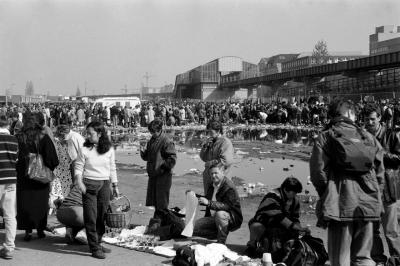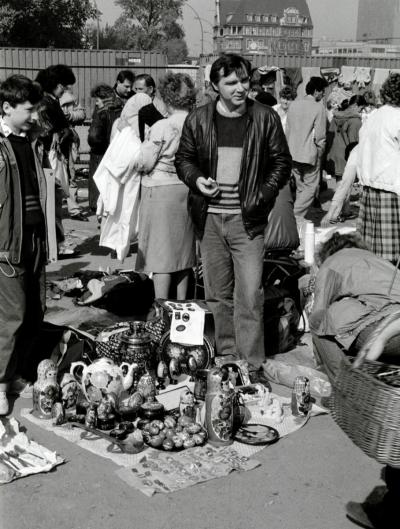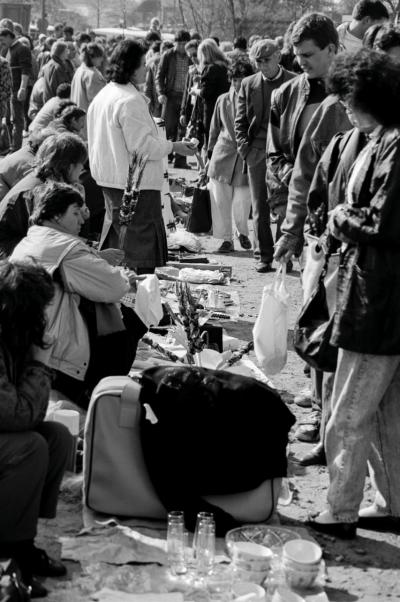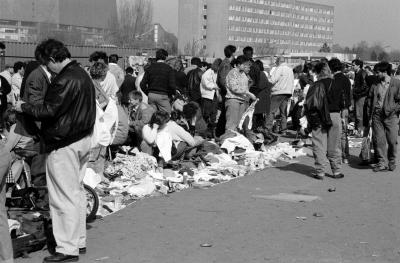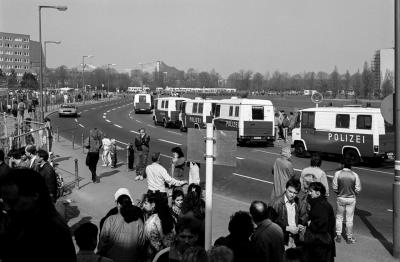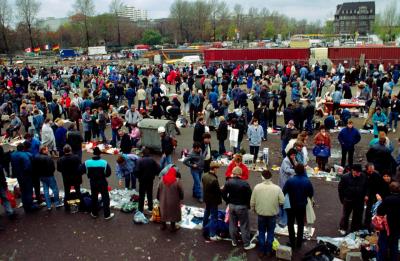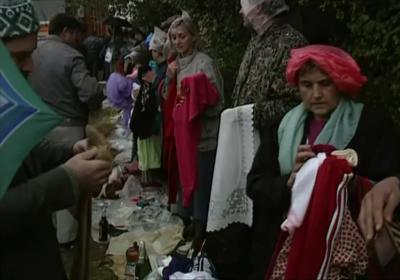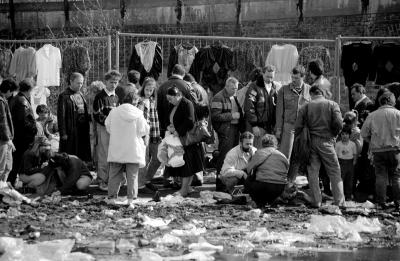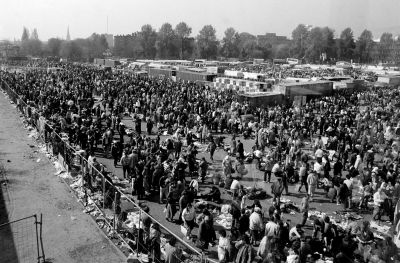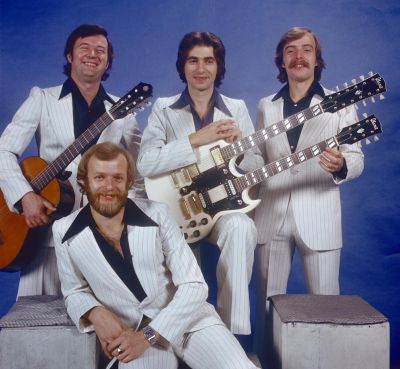The "Polenmarkt" at Potsdamer Platz in Berlin

“West Berlin, West Berlin, on every second pavement stands a Pole”, sang the band "Big Cyc"in 1990, and the satirical lyrics were perfectly in line with reality. The song was written after the band had travelled by train to a concert in Germany. On an overcrowded train from Warsaw to Berlin, the musicians soon realized that there was no one among their fellow travellers who wanted to visit West Berlin as a tourist. Their luggage consisted of all kinds of goods - from foodstuffs, such as Polish sausages, meat, eggs, butter and marinated mushrooms, via dishes and clothing, live and stuffed animals, to the mandatory cartons of cigarettes and alcohol. All these products were destined for the Polish market on the Reichpietschufer, very close to Potsdamer Platz, which still lay empty at that time.
In 1989 and 1990 such scenes were constant occurrences on trains leaving Polish cities for Berlin. At its height the market expanded so rapidly that the borders of West Berlin, which was still separated from East Berlin by the Wall, were crossed daily by up to 300 buses, dozens of trains and an unpredictable number of tiny Fiats.[1]
The mass stampede to West Berlin was helped by the abolition of visa requirements for Polish travellers in early 1989. Every citizen of the People's Republic of Poland was now allowed a passport without the threat of harassment by the Communist security apparatus. West Berlin attracted the Poles like a magnet, as this was the only city open to them. Those who wanted to travel to the GDR still needed an invitation, while the authorities in the Federal Republic required an invitation, the possession of 50 DM per day and proof of health insurance. However, these rules did not apply to West Berlin. Citizens from the Eastern Bloc were allowed to stay there for 31 days in accordance with Allied regulations. A large number of Poles decided to exploit this privilege, and Berlin citizens who witnessed such scenes near the Berlin Wall saw people "(...) loaded down with nylon bags, dragging behind them overloaded two-wheeled carts. They travelled in endless lines from the border crossing at the Friedrichsstraße railway station in East Berlin to the square in front of the opera house and the park at the Landwehrkanal, until they reached the thousands of people, and "shops" on the barren spot between the Turkish flea market and the railway line used for testing the magnetic train.”[2]
The trade of the Poles "with anything whatever", in humiliating circumstances, on dusty soil and in mud, in heat and bad weather, but above all in constant fear of confiscation of goods cleared neither by Customs officials nor by the police, was not so much due to their natural tendency to do business, but rather forced by the extremely precarious economic situation of many Polish families. A sale of 20 short-sleeved blouses, which cost 2 DM in Poland, could bring in a monthly income of about 40 DM in Berlin. In this respect, the Polish market was primarily a phenomenon of its time.
Initially, Berliners were naturally interested in the massive influx of Polish traders into their city. The provisional market became the destination of weekend excursions, visited by both native Germans and migrants who purchased the most peculiar articles. Most people did not worry about the existence of the Polish market until it became so large that it was difficult to control.
[1] Peter Oliver Loew, Die Unsichtbaren, C.H. Beck 2014, p. 238.
[2] Andrzej Kotula, Wschód na Zachodzie, czyli Polenmarkt w Berlinie Zachodnim w 1989-1990, [in:] Das Deutsch-Polnische Magazin DIALOG, No. 85-86/2008-2009.
The gathering of tens of thousands of people (some sources even speak of one hundred thousand) had an extremely negative impact on the environment. Since there were no public toilets in the area, the entrances to the surrounding houses quickly stank of faeces. The market was like a huge refuse dump, with rubbish accumulating in the nearby parks. Prostitution flourished in the side streets and vehicles. At the same time, there was an increase in the number of shoplifting crimes and cars stolen by Poles. Berliners were also disturbed by the way in which food was sold directly from cardboard boxes and newspapers on the ground. "As a result, it wasn't so much the trading itself and what was sold on the Polish market that began to turn the otherwise tolerant Germans against them. This tolerance then turned into anger, which then gradually turned into hostility."[3]
Constant violations of the law and disregard for sanitary regulations inevitably led the city's inhabitants to make increasingly loud demands on politicians to keep the market in order. Every Monday, the Berlin newspapers vied with each other in assessing the numbers of illegal traders from Poland who had been found guilty of illegal trafficking and crimes at the weekend. Politicians of all parties warned against the creation of "Polish slums". German owners of small shops who were in fear of competition from cheap goods also protested against the Polish market. They were supported by animal rights activists who warned people against buying parrots, dogs and cats.
However, the attempt to stop the illegal trade was like a Quixotic fight against windmills. Nothing helped: neither the closing of access roads to the market nor the erection of signs in Polish telling them about the ban on sales. After the market area had been fenced off, traders moved on to the vicinity of the Philharmonic Hall until, after several such spontaneous moves, the market finally returned to its old location. Speedy criminal proceedings were launched against dealers arrested by the police. Customs officers stamped their passports with a three-year ban on entering West Berlin. In the first few months of trading on the market alone, 3,171 persons received such entries in their papers. Criminal proceedings were initiated against 4,500 persons.[4] However, these measures were of no significant benefit, since many traders simply reported the loss of their passport to the Polish authorities and applied for a new one to enable them to travel back easily to West Berlin.
All this had a negative effect on the image of the Poles, with the result that the Germans' attitude towards the arrivals from the other side of the Oder suffered. Until then, Berliners had looked respectfully towards Poland, since it was not so long since the Poles had attempted to regain their freedom and the Germans had given them intellectual and material support in the difficult periods of martial law and the economic crisis of the mid-1980s.
Xenophobic sentiment was also fuelled by the media. Witold Kamiński from the Polish Social Council in Berlin, who at the time worked with the Berlin authorities and services on the Polish market recalls that "Articles in the Bild-Zeitung and the Berliner Zeitung about the Polish market mentioned things like the danger of epidemics, reminsicent of writings on the ghetto walls during the Second World War. We tried to shed some light on the phenomenon from a different perspective by showing the Germans that trading is never one-sided," he said.
In practice, the Polish market also helped Berliners to earn money. Poles spent their hard-earned money on the market in discount supermarkets like Aldi, and stores selling electronic products made in Asia. The rush for video recorders, cameras and tape recorders was so great that despite the fact that one electronics store after another began to open on the Kantstrasse in Charlottenburg where many Poles were buying up articles, there was scarcely any reduction in the long lines of customers.
The onslaught of the Poles, who made their pilgrimage to Kantstrasse after finishing work in the Polish market, also left a detrimental mark on the area. In 1990, "Der Spiegel" described what was happening there as follows:"Because bulky packaging cartons are only a disturbance during transport, they are abandoned on the spot - in parking spaces on the road or in the nearest hallway. Empty beer cans and broken soda bottles, paper cups and hamburger boxes collect in the gutter. And since travellers have been on the road for hours, they are forced to answer urgent calls of nature."[5]
Local residents, who developed an increasing aversion to Polish traders, received support from politicians. In 1987, Ulf Fink, the then Senator for Health and Social Affairs in Berlin, still believed that West Berlin should be interested in Polish immigrants for economic and demographic reasons. Only two years later, however, politicians noted that "the boat was full", and that Berlin's difficult situation on the housing market would only be exacerbated by the further influx of repatriates from the Soviet Union.[6]
In order to subdue the onslaught of "Polish trading tourists", as the phenomenon was often described in the press, the West Berlin Senate called on the Federal Government to relax the entry regulations into Germany and create an "immigration union" stretching from Frankfurt an der Oder to Aachen. The aim was to ensure that travellers from Poland also visited other German cities. In this respect, the Polish market was a constant source of discussion in the meetings of the Berlin Senate. At the same time, increasingly harsher letters were being sent to Warsaw begging the authorities to stop the mass travel of Poles for commercial purposes.
By the end of 1990, the Polish market had finally disintegrated spontaneously. As a result of the reforms introduced by Leszek Balcerowicz, the prices of goods sold in Poland rose sharply, while journeys to Berlin and the price of petrol became more expensive. At the same time, the value of the Deutschmark fell so sharply that trading was no longer profitable. As a result, the Polish market had a brief revival in 1992, but never again reached its former dimensions. Today, Potsdamer Platz, packed with glossy office buildings, is also a place of commerce. With the establishment of the more-or-less exclusive shops, Poles have also returned, but this time as customers.
Monika Stefanek, December 2017
[5] “Arme Teufel”: Der Spiegel, 17/1990, p. 105.
[6] Blog by Uwe Rada, Von Danzig bis Berlin, at: www.uwe-rada.de
